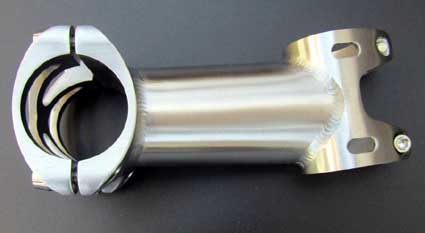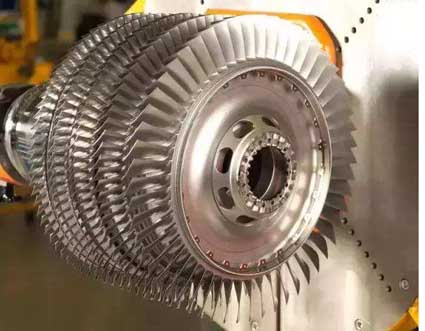Application and Development of Titanium Alloy Materials and Titanium Precision Parts in Engines
Key words: engine titanium material, high temperature titanium alloy, Ti-6Al-4V precision titanium parts, TiAl-based titanium alloy
The superior combat performance of modern military fighters such as tactical maneuverability, short takeoff, and supersonic cruise is largely dependent on the application of advanced high thrust aircraft engines. The development of aeroengine with high thrust-weight ratio is closely related to the extensive application of high temperature titanium alloys. Aeroengine compressor blades, discs and casings are required to have high instantaneous strength, endurance strength, creep resistance at high temperature, structural stability and high and low cycle fatigue performance in the temperature range from room temperature to high temperature.

The jet engine is the heart of the plane. Rotating parts such as engine fans, high pressure compressor discs and blades. Not only must bear a lot of stress, but also have a certain heat resistance. That is, titanium is required to have good high temperature strength, creep resistance and oxidation resistance at a temperature of 300 to 650 °C. Under such conditions, the temperature is too high for aluminum; the density is too great for steel; titanium is the best choice. Therefore, the application of titanium in advanced engines is expanding. Titanium alloys used on aircraft are Ti-6Al-4V, Ti-8Al-1M-1V, Ti-17, Ti-6242, Ti-6246, TC6, TC9, TC11, Ti-1100, IMI829, IMI834, etc. An important performance indicator of the engine is the thrust-to-weight ratio, which is the ratio of the thrust generated by the engine to its own weight. The higher the thrust-to-weight ratio, the better the engine performance. The early engine's thrust-to-weight ratio was only 2 to 3, and it has now reached 10. Foreign countries are developing engines with a weight ratio of 10 to 20. To increase the thrust-to-weight ratio, it is necessary to increase the compression ratio (intake amount index) and intake air temperature of the front intake of the turbine. The higher the operating temperature, the higher the thermal efficiency of the engine. Increasing the thrust-to-weight ratio also increases the specific strength and specific stiffness of the material at high temperatures, reducing the weight of the engine itself. It is calculated that when the compression ratio reaches 15:1, the outlet temperature of the compressor is 590 °C. When the compression ratio reaches 25:1, the outlet temperature of the compressor reaches 620 to 705 ° C, and a titanium alloy having excellent heat resistance is required. Experiments show that conventional titanium alloy can only be used below 650 °C. In order to manufacture an advanced engine having a thrust-to-weight ratio of 10 or more, it is necessary to develop a titanium alloy based on a titanium-based composite material, a Ti3Al, and a TiAl-type intermetallic compound. The most practical heat-resistant titanium alloys are the IMI829, IMI834 and Ti-1100 in the United States. They have been used in V2500, EJ2000, 55-712 retrofit engines.

According to the application status of titanium alloys, high temperature titanium alloys (for engines) and high damage tolerance titanium alloys (for fuselage) are the two main directions for the future development of titanium alloys. The use of material design methods is one of the effective ways to prepare low-cost titanium alloys. IMI834 and Ti-1100 are high-temperature titanium alloys used at 600 °C, which basically meet the requirements of engines with a push-to-weight ratio of 10. However, above 600 ° C, the sharp decline in creep resistance and high temperature oxidation resistance is the two major obstacles limiting the use of titanium alloys in higher temperatures. Compared with general titanium alloys, the most advantageous advantages of Ti3Al(α2) and TiAl(γ) intermetallic compounds based on titanium-aluminum compounds are high temperature performance. (They have a maximum operating temperature of 700 and 850 ° C, respectively), strong oxidation resistance and good creep resistance. In order to satisfy an engine having a thrust-to-weight ratio of more than 10 at 650 ° C or higher, it is necessary to develop TiMMC (titanium metalmatrix composite-titanium-based metal-based composite material), Ti3Al-based, and TiAl-based titanium alloy.

However, in recent years, the competition in the aviation industry has intensified, and people have to consider the manufacturing cost of the aircraft instead of simply pursuing the performance of the aircraft. In order to make titanium alloys more widely applicable, it is necessary to reduce the use cost of titanium alloys. One of the reasons for the high cost of titanium alloys is the high cost of alloying elements. Therefore, it is of great practical value to design expensive grades of alloys by replacing expensive Nb, Mo and V elemental genus with inexpensive Fe, Cr, Ni, Mn and alloys of these elements.
The superior combat performance of modern military fighters such as tactical maneuverability, short takeoff, and supersonic cruise is largely dependent on the application of advanced high thrust aircraft engines. The development of aeroengine with high thrust-weight ratio is closely related to the extensive application of high temperature titanium alloys. Aeroengine compressor blades, discs and casings are required to have high instantaneous strength, endurance strength, creep resistance at high temperature, structural stability and high and low cycle fatigue performance in the temperature range from room temperature to high temperature.

The jet engine is the heart of the plane. Rotating parts such as engine fans, high pressure compressor discs and blades. Not only must bear a lot of stress, but also have a certain heat resistance. That is, titanium is required to have good high temperature strength, creep resistance and oxidation resistance at a temperature of 300 to 650 °C. Under such conditions, the temperature is too high for aluminum; the density is too great for steel; titanium is the best choice. Therefore, the application of titanium in advanced engines is expanding. Titanium alloys used on aircraft are Ti-6Al-4V, Ti-8Al-1M-1V, Ti-17, Ti-6242, Ti-6246, TC6, TC9, TC11, Ti-1100, IMI829, IMI834, etc. An important performance indicator of the engine is the thrust-to-weight ratio, which is the ratio of the thrust generated by the engine to its own weight. The higher the thrust-to-weight ratio, the better the engine performance. The early engine's thrust-to-weight ratio was only 2 to 3, and it has now reached 10. Foreign countries are developing engines with a weight ratio of 10 to 20. To increase the thrust-to-weight ratio, it is necessary to increase the compression ratio (intake amount index) and intake air temperature of the front intake of the turbine. The higher the operating temperature, the higher the thermal efficiency of the engine. Increasing the thrust-to-weight ratio also increases the specific strength and specific stiffness of the material at high temperatures, reducing the weight of the engine itself. It is calculated that when the compression ratio reaches 15:1, the outlet temperature of the compressor is 590 °C. When the compression ratio reaches 25:1, the outlet temperature of the compressor reaches 620 to 705 ° C, and a titanium alloy having excellent heat resistance is required. Experiments show that conventional titanium alloy can only be used below 650 °C. In order to manufacture an advanced engine having a thrust-to-weight ratio of 10 or more, it is necessary to develop a titanium alloy based on a titanium-based composite material, a Ti3Al, and a TiAl-type intermetallic compound. The most practical heat-resistant titanium alloys are the IMI829, IMI834 and Ti-1100 in the United States. They have been used in V2500, EJ2000, 55-712 retrofit engines.

According to the application status of titanium alloys, high temperature titanium alloys (for engines) and high damage tolerance titanium alloys (for fuselage) are the two main directions for the future development of titanium alloys. The use of material design methods is one of the effective ways to prepare low-cost titanium alloys. IMI834 and Ti-1100 are high-temperature titanium alloys used at 600 °C, which basically meet the requirements of engines with a push-to-weight ratio of 10. However, above 600 ° C, the sharp decline in creep resistance and high temperature oxidation resistance is the two major obstacles limiting the use of titanium alloys in higher temperatures. Compared with general titanium alloys, the most advantageous advantages of Ti3Al(α2) and TiAl(γ) intermetallic compounds based on titanium-aluminum compounds are high temperature performance. (They have a maximum operating temperature of 700 and 850 ° C, respectively), strong oxidation resistance and good creep resistance. In order to satisfy an engine having a thrust-to-weight ratio of more than 10 at 650 ° C or higher, it is necessary to develop TiMMC (titanium metalmatrix composite-titanium-based metal-based composite material), Ti3Al-based, and TiAl-based titanium alloy.

However, in recent years, the competition in the aviation industry has intensified, and people have to consider the manufacturing cost of the aircraft instead of simply pursuing the performance of the aircraft. In order to make titanium alloys more widely applicable, it is necessary to reduce the use cost of titanium alloys. One of the reasons for the high cost of titanium alloys is the high cost of alloying elements. Therefore, it is of great practical value to design expensive grades of alloys by replacing expensive Nb, Mo and V elemental genus with inexpensive Fe, Cr, Ni, Mn and alloys of these elements.





